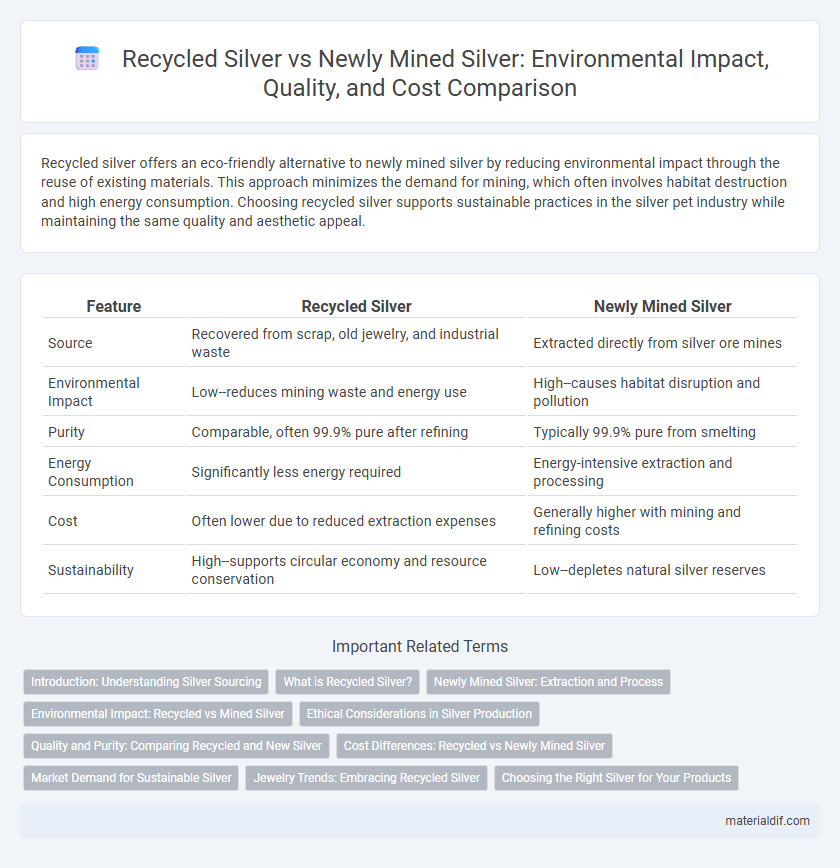Recycled silver offers an eco-friendly alternative to newly mined silver by reducing environmental impact through the reuse of existing materials. This approach minimizes the demand for mining, which often involves habitat destruction and high energy consumption. Choosing recycled silver supports sustainable practices in the silver pet industry while maintaining the same quality and aesthetic appeal.
Table of Comparison
| Feature | Recycled Silver | Newly Mined Silver |
|---|---|---|
| Source | Recovered from scrap, old jewelry, and industrial waste | Extracted directly from silver ore mines |
| Environmental Impact | Low--reduces mining waste and energy use | High--causes habitat disruption and pollution |
| Purity | Comparable, often 99.9% pure after refining | Typically 99.9% pure from smelting |
| Energy Consumption | Significantly less energy required | Energy-intensive extraction and processing |
| Cost | Often lower due to reduced extraction expenses | Generally higher with mining and refining costs |
| Sustainability | High--supports circular economy and resource conservation | Low--depletes natural silver reserves |
Introduction: Understanding Silver Sourcing
Recycled silver is sourced from repurposed materials such as old jewelry, electronic components, and industrial scrap, reducing the need for new mining activities. Newly mined silver is extracted directly from ore through mining operations, which often involve significant environmental impact and resource consumption. Understanding the distinctions between these sources highlights the importance of sustainable silver sourcing in reducing ecological footprints and promoting responsible metal use.
What is Recycled Silver?
Recycled silver is refined from scrap silver pieces, including old jewelry, electronic components, and industrial by-products, reducing the demand for newly mined silver. This process conserves natural resources and lowers environmental impact by minimizing mining-related emissions and habitat disruption. The purity of recycled silver often matches or exceeds that of newly mined silver, making it a sustainable and high-quality alternative.
Newly Mined Silver: Extraction and Process
Newly mined silver undergoes a complex extraction process starting with ore mining, followed by crushing and grinding to liberate silver particles. The silver is then separated through flotation, cyanidation, or amalgamation techniques, refining the metal to a high purity level. This process involves significant energy consumption and environmental management to mitigate the impact of mining activities.
Environmental Impact: Recycled vs Mined Silver
Recycled silver significantly reduces environmental impact by minimizing the need for energy-intensive mining processes and lowering carbon emissions associated with ore extraction and processing. Mining newly extracted silver causes habitat disruption, soil erosion, and water contamination through the release of harmful chemicals like cyanide and mercury. By contrast, recycled silver promotes sustainability by conserving natural resources and reducing the ecological footprint involved in silver production.
Ethical Considerations in Silver Production
Recycled silver significantly reduces environmental impact by minimizing the need for energy-intensive mining and limiting habitat destruction. Ethical considerations prioritize recycled silver due to its lower carbon footprint and diminished reliance on conflict minerals often associated with newly mined silver. Choosing recycled silver supports sustainable practices and ensures accountability in the silver supply chain.
Quality and Purity: Comparing Recycled and New Silver
Recycled silver maintains the same chemical composition and purity as newly mined silver, typically measured at 99.9% fine silver or higher for investment and jewelry purposes. Both recycled and newly mined silver undergo rigorous refining processes to eliminate impurities, ensuring consistent quality standards across various applications. Choosing recycled silver supports sustainable practices without compromising the metal's intrinsic value or performance in industrial and ornamental uses.
Cost Differences: Recycled vs Newly Mined Silver
Recycled silver generally costs less than newly mined silver due to lower extraction and processing expenses, which reduces overall production costs. The price difference is influenced by factors such as energy consumption, refining techniques, and supply chain efficiency inherent to recycled silver. Market demand and the environmental benefits of recycled silver also contribute to its competitive pricing compared to newly mined silver.
Market Demand for Sustainable Silver
Market demand for sustainable silver is rapidly increasing as consumers and industries prioritize environmentally friendly sourcing. Recycled silver reduces the need for energy-intensive mining operations, lowering carbon emissions and ecological impact while maintaining the same purity and quality as newly mined silver. This shift promotes circular economy principles, driving investment in silver recycling technologies and expanding the market share of recycled silver globally.
Jewelry Trends: Embracing Recycled Silver
Recycled silver is gaining popularity in jewelry trends due to its reduced environmental impact and sustainable appeal compared to newly mined silver, which involves extensive mining practices contributing to ecological degradation. Designers and consumers increasingly prefer recycled silver for its eco-friendly certification and ethical sourcing, aligning with the rising demand for responsible luxury. This shift promotes circular economy principles, reducing waste and conserving natural silver resources without compromising the metal's quality or aesthetic value in fine jewelry.
Choosing the Right Silver for Your Products
Recycled silver offers a sustainable alternative by reducing environmental impact and conserving natural resources, making it ideal for eco-conscious product lines. Newly mined silver, while often purer and more abundant, involves extensive mining processes that can lead to habitat disruption and higher carbon footprints. Selecting between recycled and newly mined silver depends on product goals, with recycled silver aligning with green manufacturing standards and newly mined silver preferred for applications demanding high material consistency.
Recycled Silver vs Newly Mined Silver Infographic

 materialdif.com
materialdif.com